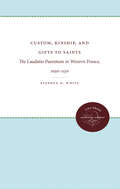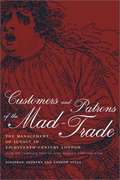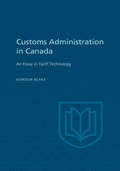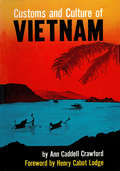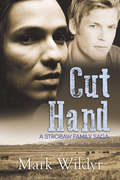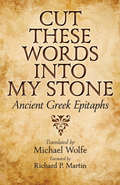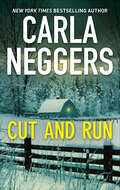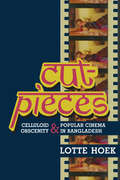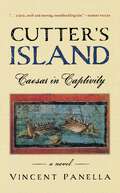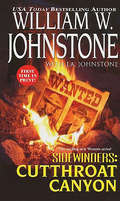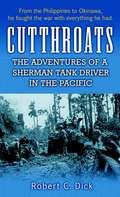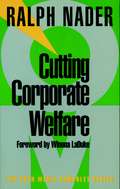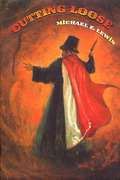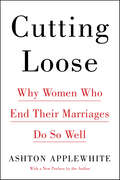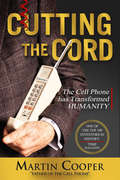- Table View
- List View
Custom, Kinship, and Gifts to Saints: The Laudatio Parentum in Western France, 1050-1150 (Studies in Legal History)
by Stephen D. WhiteWhite combines an intensive study of medieval law with insights from anthropology, religion, and social history to create a picture of French society in the Middle Ages which is impressive in its breadth and illuminating in its detail. By examining the practice whereby gifts of land were approved by the giver's relatives, he suggests novel ways of looking at early medieval law, kinship, land tenure, and gift exchange. White shows that laudatio parentum can be properly analyzed only within a combined social, legal, and religious context.Originally published in 1988.A UNC Press Enduring Edition -- UNC Press Enduring Editions use the latest in digital technology to make available again books from our distinguished backlist that were previously out of print. These editions are published unaltered from the original, and are presented in affordable paperback formats, bringing readers both historical and cultural value.
Custom, Law and the Colonial State in Northeast India: Dynamics and Challenges for the Postcolonial State
by Nandini Bhattacharyya PandaThis volume presents a multidimensional analysis of the current operational law – both constitutional and customary – in Northeast India. It looks at how colonialism redesigned and redefined extant customary practices, leaving a permanent legacy on the legal governance and societal structure of the post-colonial Indian state.The book interrogates “law” through a broad spectrum of issues including gender, partition, the legacy of colonial structures, and religion as a form of resistance against land grabbing and censorship. It delineates a distinct historical process of the evolution of law and custom and focuses on the intimate links between law and the dynamics of state, ethnicity, and governance.As a unique contribution, the book offers new insights into how and why the continuity of colonial law within a democratic framework perpetuates deep-rooted problems in governance and the psyche of the people. It will be indispensable for students and researchers of history, law, anthropology, legal anthropology, sociology, Indian politics, and South Asian studies.
Customers and Patrons of the Mad-trade: With the Complete Text of John Monro's 1766 Case Book
by Jonathan Andrews Andrew T. ScullAn important, nuanced, and fascinating account of the socio-cultural milieu that shaped and constituted the 18th-century mad-trade, centered around the clinical practice of the most famous psychiatrist in 18th-century England.
Customs Administration in Canada
by Gordon BlakeThe Canadian tariff has been a singularly faithful mirror of economic and political change in this country, but it is a glass through which much has been seen darkly. This study is an attempt to improve the view. It traces the administration of the tariff through Canadian history, and provides the first complete treatment of the subject and its significance for the country's commerce.Dr. Blake's work begins with customs administration during the French régime, and follows with the British period---the struggle for responsible government, the problem of smuggling, and the establishment of free ports. The author discusses such early problems as customs union in the Canadas, reciprocity and the Galt tariff, and ad valorem duties and their administrative consequences. Confederation and its effect on customs administration are analysed, as are the tariff schedule up to modern times, valuation and the effects of war, and the system and problems of appraisement. The customs establishment since Confederation is studied under such heads as organization, problems of adjustment, and political patronage in the service. Finally, the Canadian Tariff Board is put under examination.This study does not constitute an argument on either side of the policy controversy as regards free trade or protection nor is it a linearly historical treatment of Canadian commercial policy. It is an attempt to fit into the Canadian environment certain more or less theoretical concepts which may serve to explain the tariff as an important economic institution. It will be of interest to students of Canadian economic history, particularly in the area of national revenue.
Customs and Culture of Vietnam
by Henry Cabot Lodge Ann Caddell CrawfordA concise, information-packed background of the history and culture of Vietnam, including the country's relations with the United States. Comprehensive and authoritative, this book accurately describes this fascinating country. The author begins with a description of the geographical features of the country and the various tribes and people that inhabit it, then reviews the various religions, the educational system, and customs that have played and continue to play determinative roles in the lives of the Vietnamese. The French colonial period and its influence on the religion and educational system of the country are covered as well as such fascinating sidelights as eating habits, society, and hair styles.A separate chapter covers arts of this part of the Orient. These include the theater as well as painting, architecture, sculpture, music, and literature. Some Vietnamese legends are retold in the final chapter.Visitors to this country will be especially interested in the sections on language, customs, festivals, holidays, and recreation, not to mention places to visit.
Customs and Culture of the Philippines
by Gladys ZabilkaGaldys Zabilka, author of Customs and Culture of Okinawa, has once again created an informal and interesting compilation for the overseas traveler or the armchair tourist, this time on the colorful Philippines. The reader will be introduced to quaint customs, tourist attractions, folk songs, foods, and sports along with a general review of Philippine history and racial background. Almost very aspect of Filipino life is touched upon in this handy little volume. Delightful illustrations for each chapter were done by M. Kuwata. Musical scores of several Philippine folk songs are included in the last chapter.
Customs in Common: Studies in Traditional Popular Culture
by E. P. ThompsonThe &“meticulously researched, elegantly argued and deeply humane&” sequel to the landmark volume of social history, The Making of the English Working Class (The New York Times Book Review). This remarkable study investigates the gradual disappearance of a range of cultural customs against the backdrop of the great upheavals of the eighteenth century. As villagers were subjected to a legal system increasingly hostile to custom, they tried both to resist and to preserve tradition, becoming, as E. P. Thompson explains, &“rebellious, but rebellious in defense of custom.&” Although some historians have written of riotous peasants of England and Wales as if they were mainly a problem for magistrates and governments, for Thompson it is the rulers, landowners, and governments who were a problem for the people, whose exuberant culture preceded the formation of working-class institutions and consciousness. Essential reading for all those intrigued by English history, Customs in Common has a special relevance today, as traditional economies are being replaced by market economies throughout the world. The rich scholarship and depth of insight in Thompson&’s work offer many clues to understanding contemporary changes around the globe. &“[This] long-awaited collection . . . is a signal contribution . . . [from] the person most responsible for inspiring the revival of American labor history during the past thirty years.&” —The Nation &“This book signals the return to historical writing of one of the most eloquent, powerful and independent voices of our time. At his best he is capable of a passionate, sardonic eloquence which is unequalled.&” —The Observer
Cut Hand
by Mark WildyrFar from the world he knows, he’ll find a home. Among strangers, he’ll find acceptance. And in the arms of an unexpected man, he’ll find love. Young Billy Strobaw comes West to escape the stigma of his Tory family. In the Dakota Territories, he encounters the Yanube warrior Cut Hand. Billy’s attraction to the other man is as surprising as the Yanube perspective on same-sex love. Unlike Europeans, the Siouan tribe celebrate such unions. Billy and Cut Hand can live as partners and build a life together, which Billy agrees to do. As Billy struggles to acclimate to a very different culture, quickly discovering the Yanube have as much to teach him as he has to impart to them, a larger struggle is brewing. The white man is barreling through the Great Plains, trampling underfoot anyone who stands in his way. As a leader of his people, Cut Hand must decide whether it will be peace or war. In a historical romance taking place against the epic backdrop of the early American West, where a single spark can ignite a powder keg of greed, lust for power, and misunderstanding, one man must find his place in history and his role in the preservation of all he has come to value.
Cut Hand
by Mark WildyrFar from the world he knows, he’ll find a home. Among strangers, he’ll find acceptance. And in the arms of an unexpected man, he’ll find love.Young Billy Strobaw comes West to escape the stigma of his Tory family. In the Dakota Territories, he encounters the Yanube warrior Cut Hand. Billy’s attraction to the other man is as surprising as the Yanube perspective on same-sex love. Unlike Europeans, the Siouan tribe celebrates such unions. Billy and Cut Hand can live as partners and build a life together, which Billy agrees to do.As Billy struggles to acclimate to a very different culture, quickly discovering the Yanube have as much to teach him as he has to impart to them, a larger struggle is brewing. The white man is barreling through the Great Plains, trampling underfoot anyone who stands in his way. As a leader of his people, Cut Hand must decide whether it will be peace or war.In a historical romance taking place against the epic backdrop of the early American West, where a single spark can ignite a powder keg of greed, lust for power, and misunderstanding, one man must find his place in history and his role in the preservation of all he has come to value.
Cut These Words into My Stone: Ancient Greek Epitaphs
by Michael WolfeThe lively ancient epitaphs in this bilingual collection fit together like small mosaic tiles, forming a vivid portrait of Greek society.Cut These Words into My Stone offers evidence that ancient Greek life was not only celebrated in great heroic epics, but was also commemorated in hundreds of artfully composed verse epitaphs. They have been preserved in anthologies and gleaned from weathered headstones.Three-year-old Archianax, playing near a well,Was drawn down by his own silent reflection.His mother, afraid he had no breath left,Hauled him back up wringing wet. He had a little.He didn't taint the nymphs' deep home.He dozed off in her lap. He's sleeping still.These words, translated from the original Greek by poet and filmmaker Michael Wolfe, mark the passing of a child who died roughly 2,000 years ago. Ancient Greek epitaphs honor the lives, and often describe the deaths, of a rich cross section of Greek society, including people of all ages and classes— paupers, fishermen, tyrants, virgins, drunks, foot soldiers, generals—and some non-people—horses, dolphins, and insects. With brief commentary and notes, this bilingual collection of 127 short, witty, and often tender epigrams spans 1,000 years of the written word. Cut These Words into My Stone provides an engaging introduction to this corner of classical literature that continues to speak eloquently in our time.
Cut and Run: A Thrilling Romantic Suspense
by Carla NeggersInheriting a priceless diamond leaves a young woman at the center of a secret war reaching back to WWII in this international suspense novel.The largest uncut diamond in the world, the Minstrel’s Rough is little more than legend. Since 1548, it has been in the Pepperkamp family, handed down from one keeper to another. Now concert pianist Juliana Fall has inherited its splendor—and, unwittingly, its legacy of danger.Juliana’s mother wishes she could bury her memories of the Nazi occupation of the Netherlands. But Juliana’s safety is now entangled in the secrets of the past. For there are others who seek the Minstrel’s Rough.A U.S. senator will risk his career to claim its value. A former Nazi collaborator insists it is his destiny to possess it. And a Vietnam war hero turned journalist is chasing the story of the century. Now Juliana has only two choices: uncover the past before they do—or cut and run.
Cut-Pieces
by Lotte HoekImagine watching an action film in a small-town cinema hall in Bangladesh, and in between the gun battles and fistfights, a short pornographic clip appears. This is known as a cut-piece, a strip of locally made celluloid pornography surreptitiously spliced into the reels of action films in Bangladesh. Exploring the shadowy world of these clips and their place in South Asian film culture, Lotte Hoek builds a rare, detailed portrait of the production, consumption, and cinematic pleasures of stray celluloid.Hoek's innovative ethnography plots the making and reception of Mintu the Murderer (2005), a popular, Bangladeshi B-quality action movie and fascinating embodiment of the cut-piece phenomenon. She begins with the early scriptwriting phase and concludes with multiple screenings in remote Bangladeshi cinema halls, following the cut-pieces as they appear and disappear from the film, destabilizing its form, generating controversy, and titillating audiences. Hoek's work shines an unusual light on Bangladesh's state-owned film industry and popular practices of the obscene. She also reframes conceptual approaches to South Asian cinema and film culture, drawing on media anthropology to decode the cultural contradictions of Bangladesh since economic liberalization.
Cut-Pieces: Celluloid Obscenity and Popular Cinema in Bangladesh (South Asia Across the Disciplines)
by Lotte HoekImagine watching an action film in a small-town cinema hall in Bangladesh, and in between the gun battles and fistfights a short pornographic clip appears. This is known as a cut-piece, a strip of locally made celluloid pornography surreptitiously spliced into the reels of action films in Bangladesh. Exploring the shadowy world of these clips and their place in South Asian film culture, Lotte Hoek builds a rare, detailed portrait of the production, consumption, and cinematic pleasures of stray celluloid.Hoek's innovative ethnography plots the making and reception of Mintu the Murderer (2005, pseud.), a popular, Bangladeshi B-quality action movie and fascinating embodiment of the cut-piece phenomenon. She begins with the early scriptwriting phase and concludes with multiple screenings in remote Bangladeshi cinema halls, following the cut-pieces as they appear and disappear from the film, destabilizing its form, generating controversy, and titillating audiences. Hoek's work shines an unusual light on Bangladesh's state-owned film industry and popular practices of the obscene. She also reframes conceptual approaches to South Asian cinema and film culture, drawing on media anthropology to decode the cultural contradictions of Bangladesh since the 1990s.
Cutter's Island: Caesar in Captivity
by Vincent Panella&“This vivid short novel . . . of Caesar&’s youthful adventure. . . . Matches the film Gladiator in its vigorous, viscerally affecting depiction of ancient Rome.&” —Publishers Weekly Most of us are familiar with the Caesar of Shakespeare and Shaw. We know him primarily as the manipulative warlord and statesman. But what about the Caesar of Plutarch and Suetonius—historians who dealt with Caesar as a young man? Here, in this stunning novel, written with all the excitement and eloquence of an epic poem, we find Caesar at the age of twenty-five captured by pirates as he sails to the Island of Rhodes to study rhetoric with the renowned Apollonias Moon. &“An alternately rousing and touching adventure tale that offers an intriguing glimpse into the future dictator's psyche...[and] a panoramic view of Rome. . . . Stirring.&” —Booklist &“ . . . A lyric, swift and moving, swashbuckling tale&” —Robert Fagles, award-winning translator of The Iliad &“Cutter&’s Island is a perfect flawless gem, without a false note anywhere.&” —Steven Pressfield, author of Gates of Fire
Cutthroat Canyon: Cutthroat Canyon (Sidewinders #3)
by William W. Johnstone J.A. JohnstoneRollicking Western adventure featuring two hardheaded cowboys who veer towards the wrong side of the law by the authors of the Last Gunfighter series.Here&’s Your Gold. Now Fight for It . . . Sometimes, it&’s bad to be good. That&’s what happens when Scratch Morton and Bo Creel are rewarded with a gold mine for saving a rich man&’s bacon. The catch: this mine is a magnet for marauding Mexican banditos. Budding capitalists, Scratch and Bo fight back. That&’s when they discover that the thieves aren&’t who they thought they were, some really bad guys are on the way, and a beautiful woman might just be the most dangerous bandit of all—the kind that can steal your heart. For Scratch and Bo, this gold mine might make them rich. But it&’s more likely to get them killed—just as soon as they can figure out who wants them dead . . . Praise for the novels of William W. Johnstone &“[A] rousing, two-fisted saga of the growing American frontier.&”—Publishers Weekly on Eyes of Eagles &“There&’s plenty of gunplay and fast-paced action.&”—Curled Up with a Good Book on Dead Before Sundown
Cutthroats (A Slash and Pecos Western #1)
by William W. Johnstone J.A. JohnstoneJOHNSTONE. KEEPING THE WEST WILD.Not every Western hero wears a white hat or a tin star. Most of them are just fighting to survive. Some of them can be liars, cheaters, and thieves. And then there’s a couple of old-time robbers named Slash and Pecos . . . Two wanted outlaws. One hell of a story.After a lifetime of robbing banks and holding up trains, Jimmy “Slash” Braddock and Melvin “Pecos Kid” Baker are ready to call it quits—though not completely by choice. Sold out by their old gang, Slash and Pecos have to bust out of jail and pull one last job to finance their early retirement . . .The target is a rancher’s payroll train. Catch is: the train is carrying a Gatling gun and twenty deputy US marshals who know they’re coming. Caught and quickly sentenced to hang, their old enemy—the wheelchair-bound, bucket of mean, Marshal L.C. Bledsoe—shows up at the last minute to spare their lives. For a price. He’ll let them live if they hunt down their old gang, the Snake River Marauders. And kill those prairie rats—with extreme prejudice . . .
Cutthroats: The Adventures of a Sherman Tank Driver in the Pacific
by Robert DickSoon after we landed it became apparent that there was more than enough artillery here, that the enemy were excellent shots, and that their ammo supply seemed to be endless. With the Japanese deeply entrenched and determined to die rather than surrender, Robert Dick and his fellow soldiers quickly realized that theirs would be a war fought inch by bloody inch and that their Sherman tanks would serve front and center. As driver, Dick had to maneuver his five-man crew in and out of dangerous and often deadly situations. Whether crawling up beaches, bogged down in the mud-soaked Leyte jungle, or exposed in the treacherous valleys of Okinawa, the Sherman was a favorite target. A land mine could blow off the tracks, leaving its crew marooned and helpless, and the nightmare of swarms of Japanese armed with satchel charges was all too real. But there was a war to be won, and Americans like Robert Dick did their jobs without fanfare, and without glory. This gripping account of tanker combat is a ringing testament to the awe-inspiring bravery of ordinary Americans.
Cutting Along the Color Line: Black Barbers and Barber Shops in America
by Quincy T. MillsToday, black-owned barber shops play a central role in African American public life. The intimacy of commercial grooming encourages both confidentiality and camaraderie, which make the barber shop an important gathering place for African American men to talk freely. But for many years preceding and even after the Civil War, black barbers endured a measure of social stigma for perpetuating inequality: though the profession offered economic mobility to black entrepreneurs, black barbers were obliged by custom to serve an exclusively white clientele. Quincy T. Mills traces the lineage from these nineteenth-century barbers to the bustling enterprises of today, demonstrating that the livelihood offered by the service economy was crucial to the development of a black commercial sphere and the barber shop as a democratic social space. "Cutting Along the Color Line" chronicles the cultural history of black barber shops as businesses and civic institutions. Through several generations of barbers, Mills examines the transition from slavery to freedom in the nineteenth century, the early twentieth-century expansion of black consumerism, and the challenges of professionalization, licensing laws, and competition from white barbers. He finds that the profession played a significant though complicated role in twentieth-century racial politics: while the services of shaving and grooming were instrumental in the creation of socially acceptable black masculinity, barbering permitted the financial independence to maintain public spaces that fostered civil rights politics. This sweeping, engaging history of an iconic cultural establishment shows that black entrepreneurship was intimately linked to the struggle for equality.
Cutting Corporate Welfare (Open Media Series)
by Winona Laduke Ralph NaderIn this groundbreaking pamphlet, based on testimony he delivered before Congress, Ralph Nader describes how corporations are picking our pockets, and what we can do to stop them.While the United States continues to experience unprecedented cuts in social service programs and millions of Americans go without health insurance, massive corporations continue to reap huge sums of taxpayer money through "corporate welfare"--corporate subsidies, bailouts, giveaways, and tax escapes. Cutting Corporate Welfare details numerous appalling examples of corporate welfare, including: the giveaway of the public airwaves, which by definition belong to the people, to private radio and television stations (including the latest $70 billion gift of the digital spectrum); taxpayer subsidies for giant defense corporation mergers and commercial weapons exports to governments overseas; and the practice of making patients pay twice for drugs--first, as taxpayers subsidize the drugs' development, and again, as patients, after the federal government gives monopolistic control over the chemical's manufacture to a price-gouging drug company. Cutting Corporate Welfare sounds a wake-up call for those concerned about how we are being pick-pocketed by big business, and what we can do to stop it.
Cutting Loose
by Michael Z. Lewin"Show some respect, young man...Just what was this young woman to you?" Jackie looked into the nurse's pinkface. "Nance was the best friend I ever had," she said. "The only friend I ever had."Jackie is Jack Cross to everyone except Nance, a Wild West show trick shooter in turn-of-the-century New York who has her own secrets to hide. A slick-fielding second baseman with a good bat, Jackie must never drop her disguise if she is to continue to play professional baseball. But when Nance is murdered by a knife-thrower who does know Jackie's secret, the young ballplayer takes off on a transatlantic chase that changes her life.Set on two continents, in three different time-periods, with a fascinating cast of characters including Buffalo Bill Cody, Jack the Ripper, and a musical star named Ruby the Red who has still another hidden life, Cutting Loose is a multi-layered page-turner filled with insights and surprises.
Cutting Loose: Why Women Who End Their Marriages Do So Well
by Ashton ApplewhiteFor women contemplating divorce or for those who have already divorced, Ashton Applewhite’s insightful book sheds light on what to consider before making the decision to end your marriage, how to protect yourself—both financially and emotionally—and how much your life will change.One out of every two modern marriages ends in divorce, and 75 percent of those divorces are initiated by wives. Author Ashton Applewhite is one of these women, having sued for divorce after enduring an unfulfilling ten-year marriage. Cutting Loose is an essential resource for women who want to leave their marriage but fear the consequences.Shattering the media-generated image of the lonely, deprived and financially strapped divorcee, Applewhite provides a much needed reality check. Cutting Loose introduces 50 women, varying in age, race, class and predicament, who have thrived after initiating their own divorces. Their fears of financial, emotional and romantic ruin were never realized; on the contrary, their lives improved immeasurably, and their self-esteem soared.Cutting Loose also answers the crucial questions: How do you finally decide to make the big break? What is getting divorced really like? What are the shortcomings of the legal process? What about custody and child support? Financial and emotional survival? And how does a woman's self-image change during and after divorce? "Ending any kind of oppression takes belief in self. Cutting Loose offers moving evidence of how such belief works, whether in a relationship or walking the road alone. Perceptive, realistic, and wise, the book is of enormous practical value to both women and men who aspire to more equal and fulfilling relationships."—Laura Day, author of Practical Intuition
Cutting a Figure: Fashioning Black Portraiture
by Richard J. PowellExamining portraits of black people over the past two centuries, Cutting a Figure argues that these images should be viewed as a distinct category of portraiture that differs significantly from depictions of people with other racial and ethnic backgrounds. The difference, Richard Powell contends, lies in the social capital that stems directly from the black subject's power to subvert dominant racist representations by evincing such traits as self-composure, self-adornment, and self-imagining. Powell forcefully supports this argument with evidence drawn from a survey of nineteenth-century portraits, in-depth case studies of the postwar fashion model Donyale Luna and the contemporary portraitist Barkley L. Hendricks, and insightful analyses of images created since the late 1970s. Along the way, he discusses major artists-- such as Frédéric Bazille, John Singer Sargent, James Van Der Zee, and David Hammons--alongside such overlooked producers of black visual culture as the Tonka and Nike corporations. Combining previously unpublished images with scrupulous archival research,Cutting a Figure illuminates the ideological nature of the genre and the centrality of race and cultural identity in understanding modern and contemporary portraiture.
Cutting for Sign
by William LangewiescheWith the demise of the Berlin Wall and the Iron Curtain, there remains no more potent--or notorious--political border than the 1,951-mile division between the US and Mexico. Langewiesche shows us how a simple line--a legalism across the land--is also a mirror that reflects our ideals and fears.
Cutting the Cord: The Cell Phone has Transformed Humanity
by Martin CooperOne of Time Magazine&’s Top 100 Inventors in History shares an insider&’s story of the cellphone, how it changed the world—and a view of where it&’s headed. While at Motorola in the 1970s, wireless communications pioneer Martin Cooper invented the first handheld mobile phone. But the cellphone as we know it today almost didn&’t happen. Now, in Cutting the Cord, Cooper takes readers inside the stunning breakthroughs, devastating failures, and political battles in the quest to revolutionize—and control—how people communicate. It&’s a dramatic tale involving brilliant engineers, government regulators, lobbyists, police, quartz crystals, and a horse. Industry skirmishes sparked a political war in Washington to prevent a monopolistic company from dominating telecommunications. The drama culminated in the first-ever public call made on a handheld, portable telephone—by Cooper himself. The story of the cell phone has much to teach about innovation, strategy, and management. But the story of wireless communications is far from finished. This book also relates Cooper&’s vision of the future. From the way we work and the way children learn to the ways we approach medicine and healthcare, advances in the cellphone will continue to reshape our world for the better.
Cutting the Fuse: The Explosion of Global Suicide Terrorism and How to Stop It
by Robert A. Pape Feldman James K.Cutting the Fuse offers a wealth of new knowledge about the origins of suicide terrorism and strategies to stop it. Robert A. Pape and James K. Feldman have examined every suicide terrorist attack worldwide from 1980 to 2009, and the insights they have gleaned from that data fundamentally challenge how we understand the root causes of terrorist campaigns today--and reveal why the War on Terror has been ultimately counterproductive. Through a close analysis of suicide campaigns by Al Qaeda and other terrorist organizations in Iraq, Afghanistan, Pakistan, Lebanon, Israel, Chechnya, and Sri Lanka, the authors provide powerful new evidence that, contrary to popular and dangerously mistaken belief, only a tiny minority of these attacks are motivated solely by religion. Instead, the root cause is foreign military occupation, which triggers secular and religious people alike to carry out suicide attacks. Cutting the Fuse calls for new, effective solutions that America and its allies can sustain for decades, relying less on ground troops in Muslim countries and more on offshore, over-the-horizon military forces along with political and economic strategies that empower local communities to stop terrorists in their midst.
